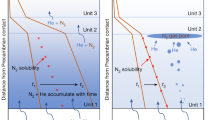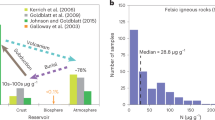Abstract
Radiogenic 4He is produced by the decay of uranium and thorium in the Earth’s mantle and crust. From here, it is degassed to the atmosphere1,2,3,4,5 and eventually escapes to space1,5,6. Assuming that all of the 4He produced is degassed, about 70% of the total 4He degassed from Earth comes from the continental crust2,3,4,5,7. However, the outgoing flux of crustal 4He has not been directly measured at the Earth’s surface2 and the migration pathways are poorly understood2,3,4,7,8. Here we present measurements of helium isotopes and the long-lived cosmogenic radio-isotope 81Kr in the deep, continental-scale Guarani aquifer in Brazil and show that crustal 4He reaches the atmosphere primarily by the surficial discharge of deep groundwater. We estimate that 4He in Guarani groundwater discharge accounts for about 20% of the assumed global flux from continental crust, and that other large aquifers may account for about 33%. Old groundwater ages suggest that 4He in the Guarani aquifer accumulates over half- to one-million-year timescales. We conclude that 4He degassing from the continents is regulated by groundwater discharge, rather than episodic tectonic events, and suggest that the assumed steady state between crustal production and degassing of 4He, and its resulting atmospheric residence time, should be re-examined.
This is a preview of subscription content, access via your institution
Access options
Subscribe to this journal
Receive 12 print issues and online access
$259.00 per year
only $21.58 per issue
Buy this article
- Purchase on Springer Link
- Instant access to full article PDF
Prices may be subject to local taxes which are calculated during checkout



Similar content being viewed by others
References
Turekian, K. K. The terrestrial economy of helium and argon. Geochim. Cosmochim. Acta 17, 37–43 (1959).
Oxburgh, E. R. & O’Nions, R. K. Helium loss, tectonics, and the terrestrial heat budget. Science 237, 1583–1588 (1987).
O’Nions, R. K. & Oxburgh, E. R. Heat and helium in the earth. Nature 306, 429–431 (1983).
Ballentine, C. J. & Burnard, P. G. Production, release and transport of noble gases in the continental crust. Rev. Mineral. Geochem. 47, 481–538 (2002).
Mamyrin, B. A. & Tolstikhin, I. N. Helium Isotopes in Nature (Elsevier, 1984).
Kockarts, G. Helium in the terrestrial atmosphere. Space Sci. Rev. 14, 723–757 (1973).
Torgersen, T. Terrestrial helium degassing fluxes and the atmospheric helium budget: Implications with respect to the degassing processes of continental crust. Chem. Geol. 79, 1–14 (1989).
Ballentine, C. J., Burgess, R. & Marty, B. Tracing fluid origin, transport and interaction in the crust. Rev. Mineral. Geochem. 47, 539–614 (2002).
Neretnieks, I. Some aspects of release and transport of gases in deep granitic rocks: Possible implications for nuclear waste repositories. Hydrogeol. J. 21, 1701–1716 (2013).
Newton, R. & Round, G. F. The diffusion of helium through sedimentary rocks. Geochim. Cosmochim. Acta 22, 106–132 (1961).
Savchenko, V. P. The problems of geochemistry of helium [in Russian]. Nat. Gases 9, 53–197 (1935).
Andrews, J. N. The isotopic composition of radiogenic helium and its use to study groundwater movement in confined aquifers. Chem. Geol. 49, 339–351 (1985).
Castro, M. C., Goblet, P., Ledoux, E., Violette, S. & Marsily, G. d. Noble gases as natural tracers of water circulation in the Paris Basin 2. Calibration of a groundwater flow model using noble gas isotope data. Wat. Resour. Res. 34, 2467–2483 (1998).
Bethke, C. M., Torgersen, T. & Park, J. The ‘age’ of very old groundwater: Insights from reactive transport models. J. Geochem. Explor. 69–70, 1–4 (2000).
Martel, D. J., Deak, J., Dövenyi, P., Horvath, F. & O’Nions, R. K. Leakage of helium from the Pannonian Basin. Nature 342, 908–912 (1989).
Aeschbach-Hertig, W., Stute, M., Clark, J. F., Reuter, R. F. & Schlosser, P. A paleotemperature record derived from dissolved noble gases in groundwater of the Aquia aquifer (Maryland, USA). Geochim. Cosmochim. Acta 66, 797–817 (2002).
Plummer, L. N. et al. Old groundwater in parts of the upper Patapsco aquifer, Atlantic Coastal Plain, Maryland, USA: Evidence from radiocarbon, chlorine-36 and helium-4. Hydrogeol. J. 20, 1269–1294 (2012).
Rebouças, A. C. Recursos Hídricos Subterrâneos da Bacia do Paraná [Underground Water Resources of the Paraná Basin] PhD thesis, Univ. São Paulo (1976)
Araújo, L. M., França, B. & Potter, P. E. Hydrogeology of the Mercosul aquifer system in the Paraná and Chaco-Paraná Basins, South America, and comparison with the Navajo-Nugget aquifer system, USA. Hydrogeol. J. 7, 317–336 (1999).
Margat, J. & van der Gun, J. Groundwater Around the World (CRC Press, 2013).
Torgersen, T. & Ivey, G. N. Helium accumulation in groundwater. II: A model for the accumulation of the crustal 4He degassing flux. Geochim. Cosmochim. Acta 49, 2445–2452 (1985).
Hitchon, B. Geochemical studies of natural gas Part III. Inert gases in Western Canadian natural gases. J. Can. Petrol. Technol. 2, 165–174 (1963).
Golubev, V. S., Yeremeyev, A. N. & Yanitskiy, I. N. Analysis of some models of helium migration in the lithosphere. Geochem. Int. 11, 734–742 (1975).
Lowenstern, J. B., Evans, W. C., Bergfeld, D. & Hunt, A. G. Prodigious degassing of a billion years of accumulated radiogenic helium at Yellowstone. Nature 506, 355–358 (2014).
Johnston, R. H. Hydrologic Budgets of Regional Aquifer Systems of the United States for Predevelopment and Development Conditions Professional paper 1425 (US Geological Survey, 1999).
Heaton, T. H. E. Rates and sources of 4He accumulation in groundwater. Hydrol. Sci. J. 29, 29–47 (1984).
Kulongoski, J. T., Hilton, D. R. & Selaolo, E. T. Climate variability in the Botswana Kalahari from the late Pleistocene to the present day. Geophys. Res. Lett. 31, L10204 (2004).
Hunt, A. G., Labert, R. B. & Fahlquist, L. Sources of Groundwater Based on Helium Analyses in and near the Freshwater/Saline-Water Transition Zone of the San Antonio Segment of the Edwards Aquifer, South-Central Texas, 2002–03 Sci. Inv. Report 2010-5030 (US Geological Survey, 2010).
Aggarwal, P. K., Araguas-Araguas, L., Choudhry, M., van Duren, M. & Froehlich, K. Lower groundwater 14C age by atmospheric CO2 uptake during sampling and analysis. Ground Water 52, 20–24 (2014).
Lu, Z-T. et al. Tracer applications of noble gas radionuclides in the geosciences. Earth Sci. Rev. 138, 196–214 (2014).
Plummer, L. N. & Glynn, P. D. Isotope Methods for Dating Old Groundwater 125–152 (IAEA, 2013).
Acknowledgements
W.J., Z-T.L., P.M. and the Laboratory for Radiokrypton Dating at Argonne are supported by DOE, Office of Nuclear Physics, under contract DE-AC02-06CH11357. Development of the ATTA-3 instrument was supported in part by NSF EAR-0651161. C. Sambandam, L-F. Han, D. Hillegonds, P. Klaus, S. Terzer and E. Izweski of IAEA assisted in noble gas analysis or with graphic illustrations.
Author information
Authors and Affiliations
Contributions
P.K.A. initiated the project and conceived of the proposed mechanism for crustal degassing; P.K.A., N.C.S., H.K.C. and D.G. designed and conducted the sampling campaign with assistance from L.J.A-A. and W.J.; R.Y. and R.P. purified krypton, W.J., Z-T.L. and P.M. measured krypton isotopes, T.M. conducted noble gas analysis and model calculations; P.K.A. and T.M. wrote the paper with assistance from L.J.A-A.; H.K.C., D.G., N.C.S. and T.T. contributed to data evaluation and presentation. All authors reviewed and commented on the manuscript.
Corresponding author
Ethics declarations
Competing interests
The authors declare no competing financial interests.
Supplementary information
Supplementary Information
Supplementary Information (PDF 699 kb)
Rights and permissions
About this article
Cite this article
Aggarwal, P., Matsumoto, T., Sturchio, N. et al. Continental degassing of 4He by surficial discharge of deep groundwater. Nature Geosci 8, 35–39 (2015). https://doi.org/10.1038/ngeo2302
Received:
Accepted:
Published:
Issue Date:
DOI: https://doi.org/10.1038/ngeo2302
This article is cited by
-
Primary N2–He gas field formation in intracratonic sedimentary basins
Nature (2023)
-
Earthquakes control the impulsive nature of crustal helium degassing to the atmosphere
Communications Earth & Environment (2022)
-
Cosmogenic nuclide techniques
Nature Reviews Methods Primers (2022)
-
Enhanced detection limits for radiokrypton analysis
Journal of Radioanalytical and Nuclear Chemistry (2020)
-
Reconciling contradictory environmental tracer ages in multi-tracer studies to characterize the aquifer and quantify deep groundwater flow: an example from the Hutton Sandstone, Great Artesian Basin, Australia
Hydrogeology Journal (2020)



